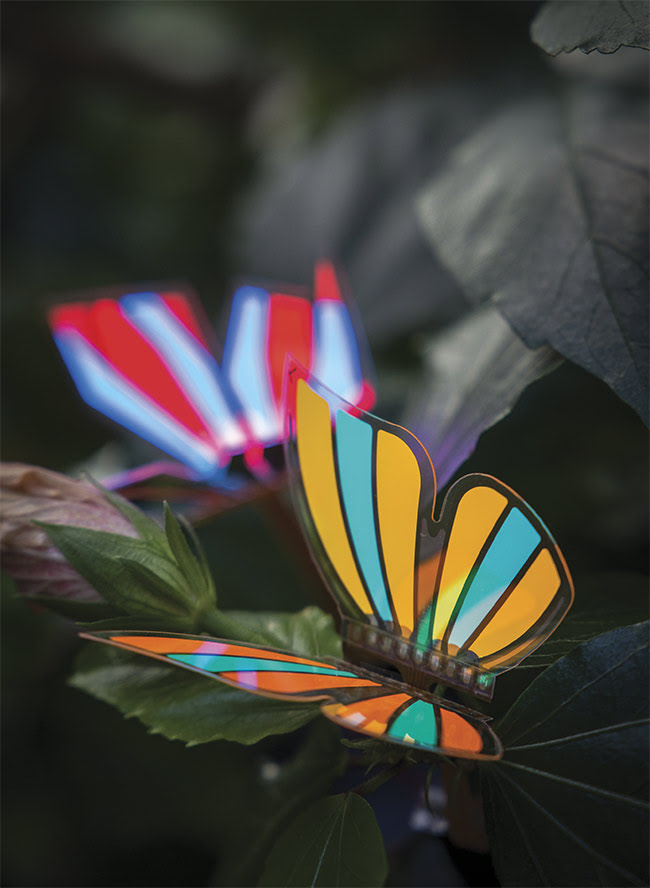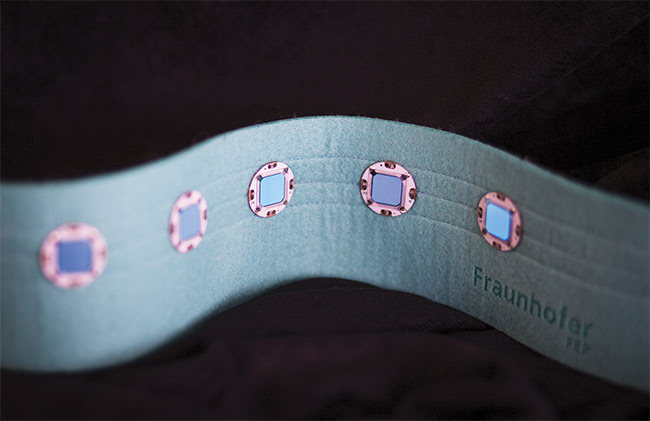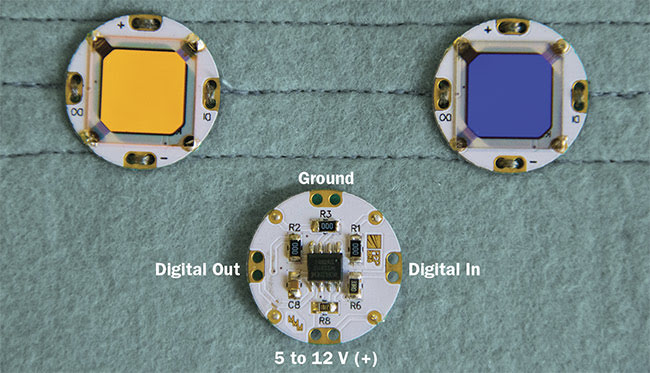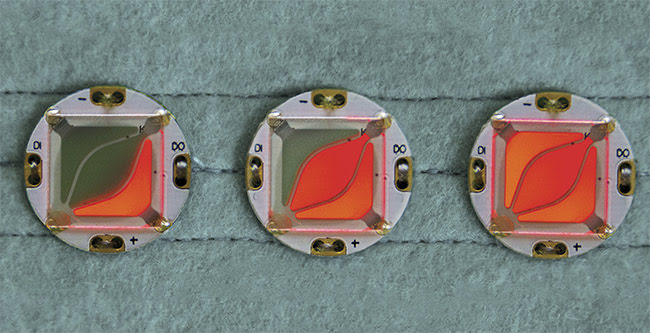Smart textiles that incorporate OLEDs can improve people’s lives in terms of safety, health, and even fashion.
JAN HESSE, FRAUNHOFER INSTITUTE FOR ORGANIC ELECTRONICS, ELECTRON BEAM AND PLASMA TECHNOLOGY FEP
Flexible organic light-emitting diode (OLED) elements are destined for integration into textiles, and they promise to be an optimal technology for integrating light into clothing and other cloth surfaces. The demand for flexible
OLED integration into garments is already on the rise. OLED-based lighting elements have outstanding characteristics, including high pliability and low weight, which make them ideal for use in fashion clothing or accessories. Beyond consumer-oriented fashion, flexible OLEDs have potential professional applications in security, emergency and rescue, and the outdoor or fitness industries.

A butterfly-shaped OLED lighting module representing a variety of design features. Courtesy of Fraunhofer FEP.
Among the most outstanding features of OLED technology are its high-quality, nonglaring area lights; its crisp, beautifully saturated colors; and its plethora
of possible shapes. As light-emitting graphical elements, they can be formed, patterned, or inscribed in numerous ways. Versatility makes these tiny lights highly attractive for the creative industry.
Design and features
Segmentation: Not only can the active area of an OLED module take any shape, it can be divided into separate and individually controllable parts or segments. And since each segment has its own electrode, it can be lit and dimmed independently. Thus, segmented OLED modules facilitate dynamic lighting effects on a single OLED module.
Patterning and logos: The active area
of OLED modules can be designed in such a way that only a mesh or grid lights up, while the interspaces between the active areas remain completely transparent. One option is the laser inscription of logos, text, or patterns into the active area. Inscriptions can be combined with color-variable OLED stacks.
Transparency: Because the top electrode is a silver or aluminum material, it appears as a reflective or mirrored surface on standard (opaque) OLED modules. The thickness of this top electrode can be reduced to a few nanometers to produce
a semitransparent electrode for a semitransparent OLED device. Therefore,
the OLED is invisible when switched off, but emits light on both sides when switched on.
Area and mixed color: If a segmented OLED design requires different colors on segments within a single OLED module, it is possible to deposit various emission colors in neighboring segments. This is
a powerful feature especially for dynamic signage applications. There is also the possibility of mixing two colors by stacking two separate emitters on parts of the active area. This type of stacking results in a mixed emission color; for example, blue and yellow mixed to create white.
Variable color: Two different OLED units (colors) can also be stacked on top
of each other with a transparent intermediate electrode and, if all electrodes remain separate, each color can be controlled independently. Mixtures of both colors can be realized by dimming each one independently. This is applicable to
a three-color system, which enables RGB-OLED on the same area without resorting to subpixelation. Furthermore, this technology can be applied both to a single active area and to a segmented layout.
Platform for textile integration
The latest technologies and materials can be combined to produce and integrate OLED prototypes and lighting elements in a small series. For example, small-molecule-based OLED stacks have a higher efficiency, greater brightness, broader variety of features (such as color variability), and longer lifetime when compared to polymer OLED systems. And they are applied via thermal vapor deposition instead of the printing/annealing approach used by polymer-based OLED systems. Thermal vapor deposition can use purer materials and produce OLED layer systems with many individual layers, which ultimately leads to better performance.
One of the most in-demand features for textile integration is a reliable electrical connection.
One of the most in-demand features for textile integration is a reliable electrical connection. For a flexible OLED integration, the connection becomes even more important because of the thinness of conductive oxide layers and the brittleness of the encapsulation layers of the substrate films.
One solution exploits the thinness
and unbreakability or robustness of flexible web-based OLED devices. It’s a
lighting element, called an O-BUTTON, that has the size and appearance of a conventional button. It consists of a circular rigid printed circuit board (PCB) made of FR4, which is a composite material composed of woven fiberglass cloth with an epoxy resin binder that is flame resistant.
One side of the PCB has a web-based, electrically conductive OLED module applied to it, along with four metallized double holes, similar to conventional garment buttons. The four-hole design ensures ease of handling with all conventional sewing machines that offer a button-sewing capability. The metallized double holes act as both mechanical and electrical connections to the garment, enabling the specialized button to be
connected to a conductive path in the
garment via conductive yarn that also serves as the mechanical fixation to the garment (Figure 1). Using stretchable conductive yarn, or a seam shape that supports stretching, means the OLED can also be applied to a textile base that may be exposed to strain.

Figure 1. A flexible OLED attached to cloth using conductive yarn. Courtesy of Fraunhofer FEP.
The flip side of the PCB provides space for a controller and additional passive components. In an ideal application scenario, a significant number of OLEDS on a garment can be controlled to achieve dynamic lighting effects. To reduce the number of driving lines required for man-
aging multiple OLEDs, a controller is used. Here, the highly compatible WorldSemi WS281x controller was selected,
as it offers three channels and allows
manipulation of multiple OLEDs connected in a chain via the Serial Peripheral Interface (SPI) protocol. In addition, only three wires are necessary: a 5-V current wire, a ground wire, and one data line. Thus, the four sets of double holes are used in this way: the first set for the 5-V current, the second for ground, and the remaining two sets provide the data line input and output, respectively (Figure 2).

Figure 2. O-BUTTONs, front and back, with a color-tunable OLED module. Courtesy of Fraunhofer FEP.
Since each controller and each OLED carries a three-channel controller, the simplest feature is switching the OLED on and off via pulse width modulation (PWM). This leaves two channels free. To be able to use all three channels, the OLED can feature a trisegmentation (Figure 3), or the OLED module can be a color-variable OLED stack (Figure 2).

Figure 3. O-BUTTONs with three individually addressable segments. Courtesy of Fraunhofer FEP.
Glare limits
Of course, lighting in garments is
nothing new. LED-based sequins are commonly known and have been widely used in fashion tech applications for more than two years. However, LED sequins have (potentially) much brighter light dots, which has several drawbacks. The area light emission of OLED elements
enables uniform and glare-free illumination in the range of 500 to 3000 cd/m2, which makes it also effective under outdoor daylight conditions. When a certain amount of light is required — for example, to ensure sufficient visibility
for safety reasons (such as for rescue workers or motorcyclists) — the LED dots must be driven with an appropriate brightness. Under daylight conditions, it can be assumed that LED-based lighting solutions reach a very high brightness of 20,000 cd/m2 and above, which drastically exceeds the glare limit. Since the limit for humans is 7500 cd/m2, the OLED solution offers a higher light quality and comfort compared to LED solutions.
In addition, the emission area is large, which is particularly important for professional applications such as security, where the ability to see and recognize the user may be very important. Distance estimation with these area light elements is also much easier when compared to point lights.
Outlook
The O-BUTTON is Fraunhofer FEP’s proposal for an easy integration of lighting functionality into garments. For this purpose, the institute currently is working on making the O-BUTTON washable by casting it with epoxy resin.
Looking forward, research is being carried out on encapsulation technologies and integration techniques, as well as on direct OLED coating on fibers or textiles, which is a high-demand application. International research groups have already shown initial achievements with light-emitting fibers in which the fibers were coated with polymer OLEDs.
Next steps have already been identified. It will be necessary to make the thin-film encapsulation mechanically and chemically indelible for processing with woofing and sewing machines, and for usage as part of a garment. This is a great effort that needs to be undertaken. In addition, and this is a bigger challenge, there is the need to make these fibers sliceable at any point, while keeping access to the two separated electrodes. Last but not least, the electrodes must be kept reliably separated for all subsequent process steps of fiber treatment.
These fundamental challenges will be overcome by the worldwide research and development community for OLED technology.
Meet the author
Jan Hesse (Diplom-Ingenieur) studied technical design at the Technische Universität Dresden and received a diploma in mechanical engineering in 2008. Since 2007, he has worked on research for OLEDs at Fraunhofer FEP and is responsible for OLED design and integration.